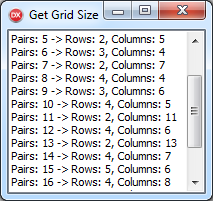 Say you are developing a game like Chess, Go, Checkers, Tic-Tac-Toe or Memory. In each of those games the game board is a rectangle looking playfield of different size (rows x columns). Tic-Tac-Toe is 3×3, Checkers is 8×8, while Go can be 19×19 or 13×13 and similar.
Say you are developing a game like Chess, Go, Checkers, Tic-Tac-Toe or Memory. In each of those games the game board is a rectangle looking playfield of different size (rows x columns). Tic-Tac-Toe is 3×3, Checkers is 8×8, while Go can be 19×19 or 13×13 and similar.
In a game with an arbitrary number of game fields you might want to have the board look as closely to square as possible (rectangle where height and width are the same). Think of Memory. Let’s say we have 24 cards, that is 12 pairs. If you want to place them in a rectangular grid, most similar to square, you would go for 4 x 6 (or 6 x 4) board size (as it would look more square like than 3 x 8 and 2 x 12 or 1 x 24 would be too wide).
Continue reading
